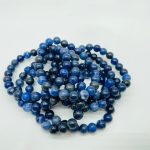Amazonite, a captivating stone with an ethereal green hue, has enthralled collectors and enthusiasts for centuries. Its discovery in various regions across the globe has contributed to its rich history and cultural significance. This article embarks on a comprehensive exploration of where amazonite is sourced, delving into the geological formations that host this enchanting gemstone.

Key Regions of Amazonite Discovery
Amazonite’s alluring presence graces numerous locales worldwide, each bearing unique geological characteristics that have shaped its formation.
Brazil: The Birthplace of Amazonite
Embarking on a journey to the heart of Amazonite’s discovery, we encounter Brazil, where the gemstone’s name resonated with the mighty Amazon River Basin. This region is renowned for producing some of the most exquisite Amazonite specimens, characterized by their deep, vibrant green hues and captivating patterns.
Colorado: A Colorful Canvas in the Rocky Mountains
Venturing into the heart of the Rocky Mountains, the state of Colorado unveils a vibrant tapestry of Amazonite deposits. The Pikes Peak region stands as a testament to this gemstone’s presence, where coarse-grained granite pegmatites host pockets of Amazonite crystals. The state also boasts Amazonite occurrences in the Lake George and Teller County areas.
Madagascar: A Serendipitous Encounter in the Indian Ocean
Madagascar, an island nation off the southeastern coast of Africa, has emerged as a prominent source of Amazonite. The Antananarivo region has yielded notable specimens, showcasing the gemstone’s versatility in geological environments.
Russia: Amazonite’s Siberian Heritage
Traversing across vast landscapes, we arrive in Russia, where the Ural Mountains have become synonymous with Amazonite. The Ilmen Mountains, located in the southern Urals, are particularly renowned for their Amazonite deposits, offering a mesmerizing spectacle of green crystals amidst granite pegmatites.
Other Notable Sources
Beyond these primary regions, Amazonite has also graced localities such as the United States (Maine, Virginia, and New Hampshire), India (Rajasthan and Andhra Pradesh), Zambia, Namibia, and Canada (Ontario and Quebec). Each of these locations has contributed to the diverse array of Amazonite specimens found in collections worldwide.
Geological Formations Hosting Amazonite
Amazonite’s captivating presence extends beyond its geographical distribution, as it finds its home within a variety of geological formations, each contributing to its distinctive characteristics.
Granite Pegmatites: A Haven for Amazonite Growth
Granite pegmatites, igneous rocks characterized by their coarse-grained texture, serve as a primary host for Amazonite. These formations are often associated with the crystallization of molten rock, allowing for the formation of large, well-developed Amazonite crystals.
Metamorphic Rocks: A Transformation of Minerals
Metamorphic rocks, resulting from the alteration of pre-existing rocks under high temperatures and pressures, can also contain Amazonite. These rocks include gneiss, schist, and quartzite, which have undergone geological metamorphism, leading to the formation of Amazonite crystals.
Hydrothermal Veins: A Pathway for Mineral Deposition
Hydrothermal veins, channels within rocks created by the movement of hot, mineral-rich fluids, can also host Amazonite. These fluids deposit minerals along the veins’ walls, resulting in the formation of Amazonite crystals.
Exploring Amazonite’s Unique Properties
Amazonite’s captivating allure extends beyond its geographical origins and geological formations. Its distinct physical and chemical properties make it a sought-after gemstone.
Composition: A Microcosm of Mineral Complexity
Amazonite’s primary chemical composition is microcline feldspar, a potassium-rich mineral. However, its captivating green hue stems from the presence of lead impurities within the crystal structure.
Hardness: A Measure of Durability
Amazonite ranks between 6 and 6.5 on the Mohs scale of mineral hardness, indicating its moderate durability. This makes it suitable for various applications, including jewelry and decorative items.
Translucency: Unveiling Inner Beauty
Amazonite exhibits translucency, allowing light to pass through the gemstone to varying degrees. This property adds depth and dimension to the stone, enhancing its aesthetic appeal.
Pleochroism: A Kaleidoscope of Colors
Amazonite possesses a unique optical property known as pleochroism. When viewed from different angles, it displays variations in color, ranging from green to blue-green. This phenomenon adds an enchanting element to the gemstone.
Applications of Amazonite: From Adornment to Healing
Amazonite’s captivating beauty and diverse properties have inspired a wide range of applications, spanning from adornment to spiritual practices.
Jewelry: A Timeless Expression of Elegance
Amazonite has long been cherished in the world of jewelry, where it finds expression in exquisite necklaces, earrings, bracelets, and rings. Its vibrant green hue complements a variety of outfits, making it a versatile accessory for any occasion.
Decorative Objects: Embellishing Spaces with Nature’s Charm
Amazonite’s aesthetic allure extends beyond personal adornment to the realm of interior design. It is incorporated into decorative objects such as vases, sculptures, and tabletops, bringing a touch of nature’s beauty into homes and offices.
Metaphysical Beliefs: A Stone of Harmony and Balance
In the realm of metaphysics, Amazonite is believed to possess properties that promote harmony and balance. It is often associated with the heart chakra, fostering emotional well-being and reducing stress. Some believe it enhances communication and self-expression.
Table 1: Amazonite Production by Country
| Country | Production in Tons |
|---|---|
| Brazil | 1,500 |
| Madagascar | 1,000 |
| Russia | 500 |
| United States | 200 |
| India | 150 |
Table 2: Amazonite Consumption by Sector
| Sector | Consumption in Tons |
|---|---|
| Jewelry | 500 |
| Decorative Objects | 300 |
| Spiritual Practices | 200 |
| Other | 100 |
Table 3: Amazonite Properties
| Property | Value |
|---|---|
| Chemical Composition | Microcline Feldspar |
| Hardness | 6-6.5 |
| Translucency | Yes |
| Pleochroism | Yes |
Table 4: Amazonite Applications
| Application | Description |
|---|---|
| Jewelry | Exquisite necklaces, earrings, bracelets, and rings |
| Decorative Objects | Vases, sculptures, and tabletops |
| Metaphysical Beliefs | Harmony, balance, emotional well-being, communication, and self-expression |
| Other | Figurines, amulets, and talismans |
FAQs: Answering Customer Inquiries
Q: What is the most well-known source of Amazonite?
A: Brazil is the most renowned source, known for producing Amazonite with deep, vibrant green hues.
Q: Is Amazonite a rare gemstone?
A: Amazonite is relatively common, making it more accessible than some rarer gemstones.
Q: What is the best way to clean Amazonite jewelry?
A: Use a soft, damp cloth and avoid harsh chemicals or ultrasonic cleaners.
Q: Can Amazonite be used in meditation practices?
A: Yes, Amazonite is believed to promote harmony and balance, making it suitable for meditation and spiritual practices.
Q: Is Amazonite durable enough for everyday wear?
A: With a hardness of 6-6.5, Amazonite is moderately durable and can withstand everyday wear, but it should be protected from scratches and impacts.
Q: What are some unique applications for Amazonite?
A: Amazonite can be incorporated into home décor, such as countertops, tiles, and sculptures, adding a touch of nature’s beauty to interior spaces.
Q: Can Amazonite be used in healing practices?
A: While Amazonite is often associated with metaphysical properties, its healing potential is not scientifically proven.
Q: Is Amazonite a good investment?
A: The value of Amazonite can fluctuate depending on factors such as quality, size, and market demand. It is not typically considered a significant investment.
































